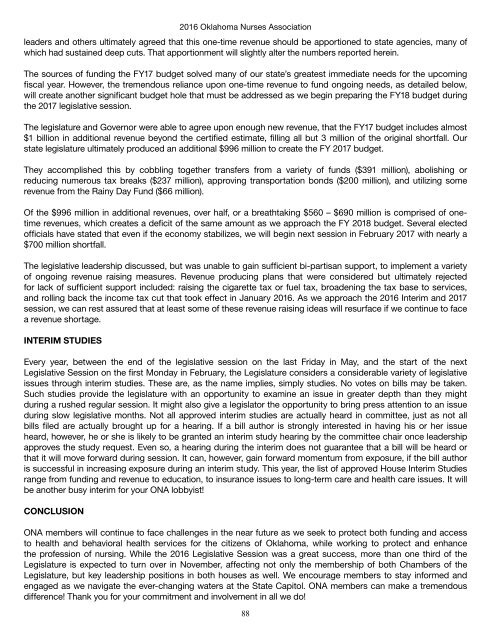2016 Oklahoma Annual Book of Reports
Create successful ePaper yourself
Turn your PDF publications into a flip-book with our unique Google optimized e-Paper software.
<strong>2016</strong> <strong>Oklahoma</strong> Nurses Association<br />
leaders and others ultimately agreed that this one-time revenue should be apportioned to state agencies, many <strong>of</strong><br />
which had sustained deep cuts. That apportionment will slightly alter the numbers reported herein.<br />
The sources <strong>of</strong> funding the FY17 budget solved many <strong>of</strong> our state’s greatest immediate needs for the upcoming<br />
fiscal year. However, the tremendous reliance upon one-time revenue to fund ongoing needs, as detailed below,<br />
will create another significant budget hole that must be addressed as we begin preparing the FY18 budget during<br />
the 2017 legislative session.<br />
The legislature and Governor were able to agree upon enough new revenue, that the FY17 budget includes almost<br />
$1 billion in additional revenue beyond the certified estimate, filling all but 3 million <strong>of</strong> the original shortfall. Our<br />
state legislature ultimately produced an additional $996 million to create the FY 2017 budget.<br />
They accomplished this by cobbling together transfers from a variety <strong>of</strong> funds ($391 million), abolishing or<br />
reducing numerous tax breaks ($237 million), approving transportation bonds ($200 million), and utilizing some<br />
revenue from the Rainy Day Fund ($66 million).<br />
Of the $996 million in additional revenues, over half, or a breathtaking $560 – $690 million is comprised <strong>of</strong> onetime<br />
revenues, which creates a deficit <strong>of</strong> the same amount as we approach the FY 2018 budget. Several elected<br />
<strong>of</strong>ficials have stated that even if the economy stabilizes, we will begin next session in February 2017 with nearly a<br />
$700 million shortfall.<br />
The legislative leadership discussed, but was unable to gain sufficient bi-partisan support, to implement a variety<br />
<strong>of</strong> ongoing revenue raising measures. Revenue producing plans that were considered but ultimately rejected<br />
for lack <strong>of</strong> sufficient support included: raising the cigarette tax or fuel tax, broadening the tax base to services,<br />
and rolling back the income tax cut that took effect in January <strong>2016</strong>. As we approach the <strong>2016</strong> Interim and 2017<br />
session, we can rest assured that at least some <strong>of</strong> these revenue raising ideas will resurface if we continue to face<br />
a revenue shortage.<br />
INTERIM STUDIES<br />
Every year, between the end <strong>of</strong> the legislative session on the last Friday in May, and the start <strong>of</strong> the next<br />
Legislative Session on the first Monday in February, the Legislature considers a considerable variety <strong>of</strong> legislative<br />
issues through interim studies. These are, as the name implies, simply studies. No votes on bills may be taken.<br />
Such studies provide the legislature with an opportunity to examine an issue in greater depth than they might<br />
during a rushed regular session. It might also give a legislator the opportunity to bring press attention to an issue<br />
during slow legislative months. Not all approved interim studies are actually heard in committee, just as not all<br />
bills filed are actually brought up for a hearing. If a bill author is strongly interested in having his or her issue<br />
heard, however, he or she is likely to be granted an interim study hearing by the committee chair once leadership<br />
approves the study request. Even so, a hearing during the interim does not guarantee that a bill will be heard or<br />
that it will move forward during session. It can, however, gain forward momentum from exposure, if the bill author<br />
is successful in increasing exposure during an interim study. This year, the list <strong>of</strong> approved House Interim Studies<br />
range from funding and revenue to education, to insurance issues to long-term care and health care issues. It will<br />
be another busy interim for your ONA lobbyist!<br />
CONCLUSION<br />
ONA members will continue to face challenges in the near future as we seek to protect both funding and access<br />
to health and behavioral health services for the citizens <strong>of</strong> <strong>Oklahoma</strong>, while working to protect and enhance<br />
the pr<strong>of</strong>ession <strong>of</strong> nursing. While the <strong>2016</strong> Legislative Session was a great success, more than one third <strong>of</strong> the<br />
Legislature is expected to turn over in November, affecting not only the membership <strong>of</strong> both Chambers <strong>of</strong> the<br />
Legislature, but key leadership positions in both houses as well. We encourage members to stay informed and<br />
engaged as we navigate the ever-changing waters at the State Capitol. ONA members can make a tremendous<br />
difference! Thank you for your commitment and involvement in all we do!<br />
88

















